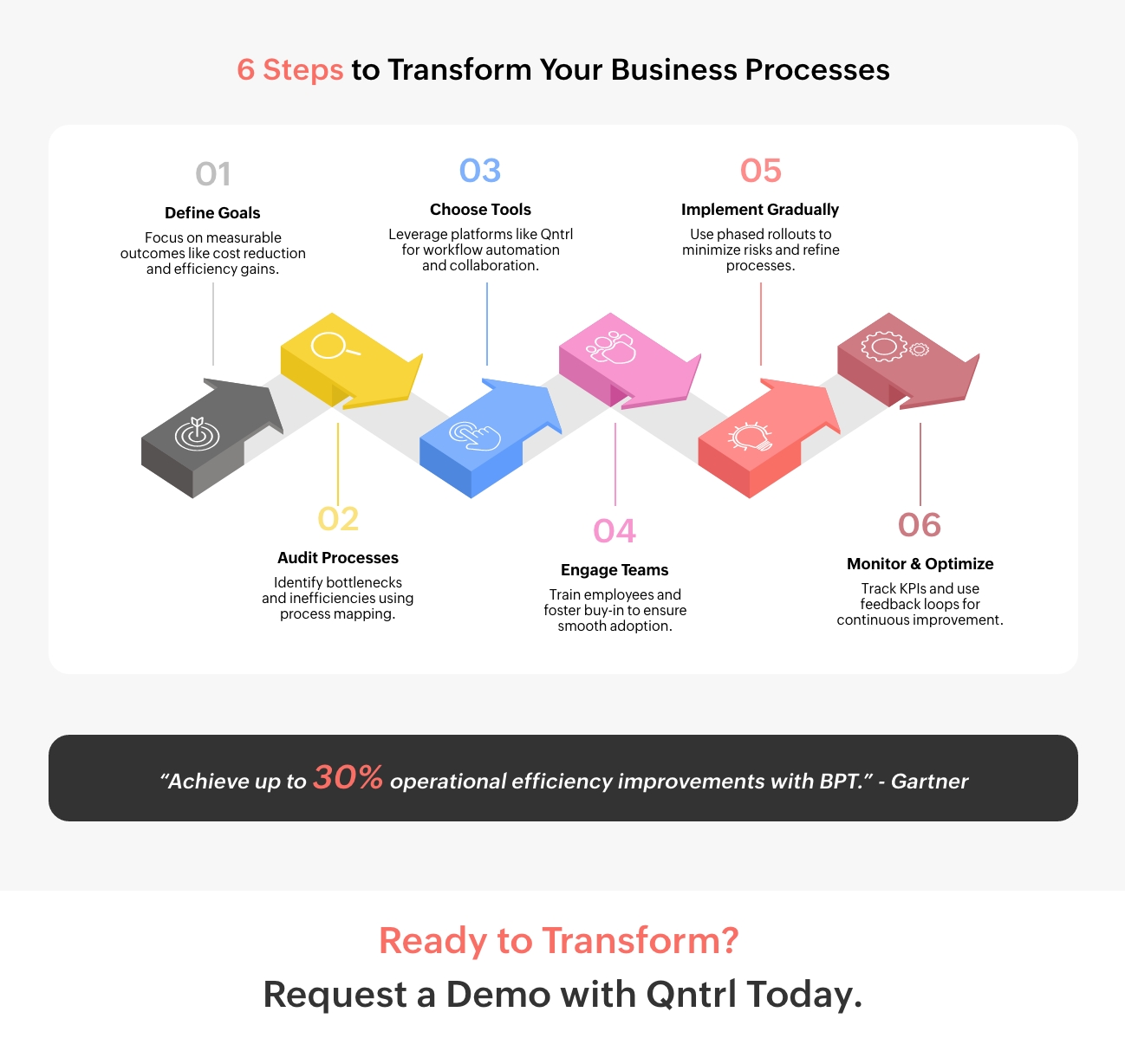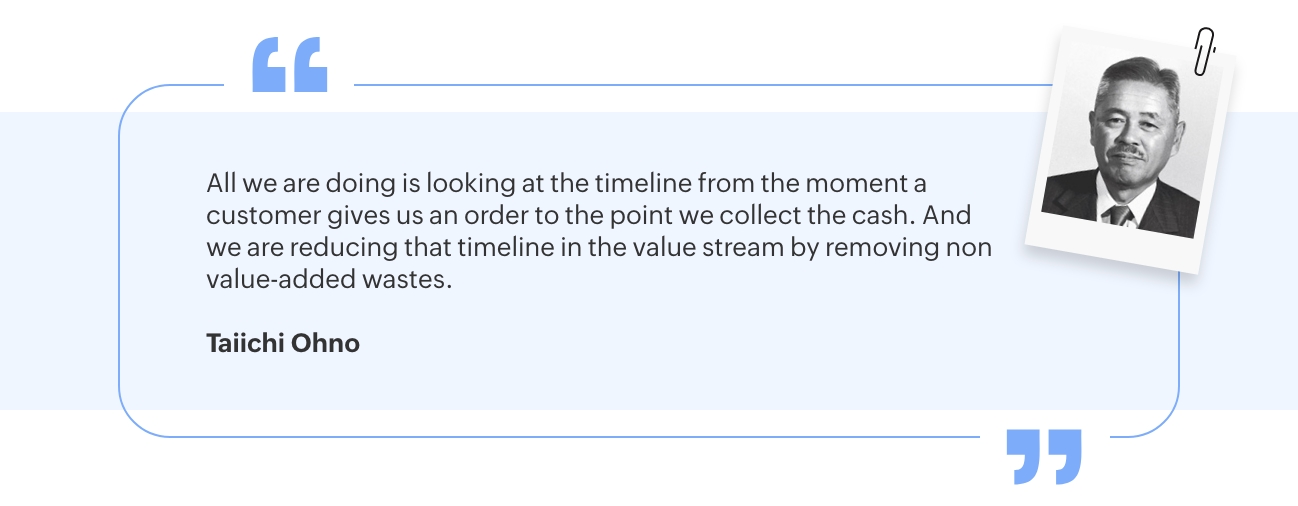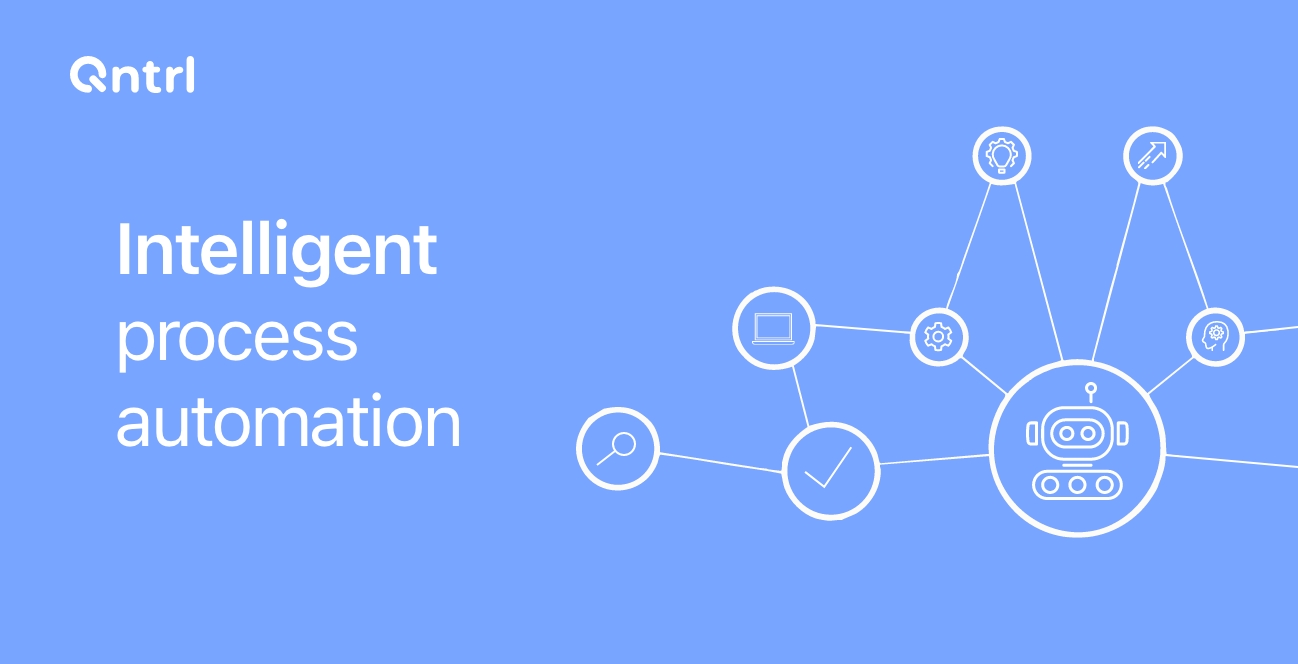Business Process Transformation Strategies: Optimize, Automate, and Grow in 2025

This article intends to help you understand whether you need a digital transformation or digital process transformation and how to go about it. In the end, we will tell you how our tool, Qntrl, can help.
Let's start with
What is digital transformation?
At some point, we've heard all the noise about digital transformation. It is believed that if you aren't digitally transformed, it is a business handicap. To get the basics clear, I asked ChatGPT to define Digital transformation, and it said
"Digital transformation refers to integrating digital technologies into all aspects of an organization, fundamentally changing how it operates, delivers value to customers, and adapts to market demands. It involves implementing new tools and technologies and a cultural shift that encourages innovation, challenges the status quo, and embraces change."
Three things to note here:
1. Using Digital Technology - We are already there; if you aren't here, you can start with this.
2. Implementation of tools- Are we really using those tools? Microsoft 365 is already there, but is the real work happening on WhatsApp?
3. Embracing change—There is only one concern here: How? How are we going to bring about that cultural shift when people are not convinced of the need for certain tools?
Business/Digital process transformation (BPT)
Here is yet another way of looking at Digital Transformation: processes! If you've decided to leverage digital tools, why not something that saves time, reduces errors, is compliant, and makes your employees happier?
That is where Digital Process Transformation comes into play. Start treating your tasks and projects as processes if they are recurring events.
Say, for example:
Sending Welcome Email
When someone signs up, send them a welcome email right away with their login details and a quick guide.
The next day, send another email showing them the best features and how to use them. A few days later, follow up with tips on advanced features.
After a week, check in to see if they've set everything up and offer help if needed. About 10 days later, ask for feedback and share support links.
Suppose this example is treated as a process with Qntrl or any other business process management tool. It would look like.

Create a Workflow: Define a workflow for "Customer Onboarding" with stages like "Sign-Up," "Feature Introduction," "Advanced Tips," "Check-In," and "Feedback."
Set Triggers: Use the trigger feature to start the workflow automatically when a new customer signs up, when a form is filled out, or when customer data is added.
Add Automation Steps:
Day 0: Configure Qntrl to automatically send the first welcome email using an email integration tool (like Gmail, Outlook, or SMTP).
Next Day: Set a timer or delay of 24 hours and automate the second email highlighting features.
A Few Days Later: Add another delay (e.g., 3 days) and automate the email with tips on advanced features.
After a Week: Set a 7-day delay to send a follow-up email with a checklist and support details.
Day 10: Schedule a feedback email 10 days after the workflow starts.
Track Progress: Each email sent can be tracked as a stage update in Qntrl. By integrating analytics tools, you can also monitor whether customers have opened or interacted with the emails.
Assign Tasks: Qntrl can assign team members tasks to follow up manually with customers who don't respond or complete onboarding steps.
Use SLA Rules: Set SLA (Service Level Agreement) rules to ensure emails are sent on time. If a stage takes too long, trigger an alert or escalate it.
Reporting: Generate reports within Qntrl to see how many customers completed onboarding, opened emails, or required additional support.
Benefits of adopting Digital Process Transformation
It automates repetitive tasks.
Customers get quicker responses.
Decisions are backed by data.
It saves time and money.
Workflows run more smoothly.
You can monitor everything live.
Teams finish tasks faster.
Automation reduces manual errors.
Teams collaborate more effectively.
Automation scales with your business.
Digital process transformation with BPM
There are many tools that can help with Process transformation, but if the BPM tool champions it, how?
Automation
It starts with triggers, like a form submission or task update, and performs actions such as sending emails, updating fields, or notifying team members. For instance, Qntrl keeps processes on track with timelines and alerts for delays while also integrating with tools like Slack or CRMs to share data.
It can run:
Numerous tasks at once
Customize workflows based on your needs
Track performance to improve
Communication
Struggling to keep everyone on the same page? Clear instructions, timely updates, and feedback loops are all within a BPM tool and through tools like emails, messaging apps, or collaboration platforms. Result? No information gaps reduce misunderstandings and efficiency.
Compliance
Compliance is all about following legal, regulatory, and organizational standards. A BPM tool maintains proper documentation, follows data security protocols, and meets industry-specific requirements with predefined workflows. It ensures operations run smoothly, reduces risks, and builds credibility by demonstrating accountability and transparency.
The Maersk case study in transformation
In 2024, Maersk transformed its procurement and supply chain operations through BPT, achieving impressive results:
40% Faster Vendor Onboarding:
A centralized platform
Automated renewals
Challenges Faced by Maersk
Integrating with outdated systems posed a significant hurdle.
New workflows initially caused anxiety and resistance.
How Maersk Conquered These Challenges
Implementing changes gradually minimized disruption and allowed for adjustments along the way.
Comprehensive training ensured employee buy-in and smooth adoption of the new processes.
Maersk's success story proves the impact of BPT when aligned with clear goals and a well-defined strategy. For an in-depth exploration, refer to the Maersk Case Study.
How do you choose the best tool?
What is your requirement? Start by understanding what you need. Are you looking to automate workflows, improve collaboration, or track processes?
Don’t choose an enterprise-grade tool if your team is small. These tools are often complex and expensive, with features you might never use. Instead, go for lightweight solutions that are easy to use and cost-effective.
Choose tools that specialize in your industry. Industry-specific tools come with built-in features tailored to your requirements, saving time and effort during setup.
Check for features. Does the tool offer what you need? Look for automation, reporting, integrations, and scalability. Don’t get swayed by fancy add-ons you won’t use.
Check reviews. Platforms like G2 and Capterra can give you a sense of how others feel about the tool. Look for feedback on user-friendliness, customer support, and overall satisfaction.
Ask AI to compare tools for your exact requirement. Use AI tools or services to narrow down your options. For example, "Compare BPT tools for a small IT team focusing on workflow automation and collaboration." Let AI do the heavy lifting to save time.
Take these steps, and you’ll find the right tool for your business.
Conquering common BPT challenges
1. Change Aversion?
Communicate changes openly and frequently. Explain the "why" behind the transformation.
Training programs are the key to equip your team with the skills they need to succeed in the new environment.
Highlight early successes to demonstrate the tangible benefits of BPT and build momentum.
2. Integration Issues? Don't Let Legacy Systems Hold You Back!
Choose tools like Qntrl, allowing gradual, incremental integration with existing systems. APIs and middleware can be crucial here.
Focus on integrating high-impact systems first for maximum benefit and to demonstrate quick value.
3. Measuring Success: Untangling the Metrics Maze
Focus on quantifiable metrics like cycle time reduction, cost savings, customer satisfaction scores (CSAT), and first-time resolution rates.
Use Dashboards to provide clear visibility into KPIs and track progress against goals. This allows for proactive adjustments and data-backed reporting.
Emerging BPT trends: Staying ahead of the curve
1. Business Process Management (BPM) Suites
BPM suites are becoming extremely sophisticated with advanced analytics, process mining capabilities, and seamless integration with other enterprise systems.
2. Process Mining for Data-Driven Insights
Process mining tools analyze event logs to uncover hidden bottlenecks and inefficiencies in workflows, providing actionable insights for optimization.
3. Collaborative Ecosystems
BPT extends beyond internal teams to include external stakeholders like suppliers, customers, and partners. Secure collaboration platforms enable seamless information sharing and joint process optimization.
Frequently Asked Questions about Business Process Transformation
How can BPT improve my procurement processes?
BPT can significantly enhance procurement workflows by automating vendor onboarding, streamlining approval cycles, and improving transparency. These changes lead to faster purchase cycles, cost optimization, and stronger vendor relationships.
What challenges should I expect during BPT implementation?
Common challenges include resistance to change, integration complexities with legacy systems, and difficulty measuring success. Overcoming these requires transparent communication, phased rollouts, and a focus on data-driven metrics.
Is BPT suitable for small and medium businesses?
Absolutely. While BPT is often associated with large enterprises, its principles apply to businesses of all sizes. Tools like Qntrl are scalable to fit any organization.
How long does it take to see results from BPT?
This depends on the scope of the transformation, but many organizations see measurable improvements—such as reduced cycle times or enhanced customer satisfaction—within 3-6 months of implementation.
Where can I start with BPT?
Begin with a process audit to identify inefficiencies and prioritize high-impact workflows. Implement phase changes and use tools like Qntrl to support automation and collaboration.
Final thoughts on BPT
If you are looking at ways to improve business operations, Business Process Transformation can help you stay ahead, not just keep up. In summary, you can achieve effective workflows that drive growth and resilience in 2025.
At Qntrl, our dedicated support team is here to help you quickly re-engineer your processes. Whether you're tackling inefficiencies or aiming for long-term scalability, we're ready to collaborate to find a solution. Let us know your challenges, and we'll provide actionable strategies to address them.
Please email us at support@qntrl.com or request a demo to take the first step toward transforming your workflows today.
Enjoying your reading?
Enjoy organization and visibility too!
Qntrl can help you organise, control and improve production and projects in your team.







